Durga’s Weapons Of War
- May 21, 2021

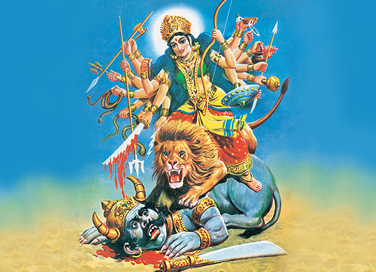
Durga’s Weapons Of War
- May 21, 2021
By Shivam Pathania
Shakti is the universal mother goddess who is the source of energy for everything; living and nonliving, divine and non-divine. She manifests in numerous forms like Parvati, Kali, Saraswati, and Lakshmi. She is loving, caring, nourishing, yet at the same time can be ferocious, menacing and destructive. Just like how energy has the potential to either create or destroy.
Durga is one such ferocious form of the mother goddess who is renowned for her battle prowess. The half buffalo and half asura, Mahishasura who was the king of asuras, easily defeated the devas due to a boon from Brahma. The boon granted the asura partial immortality as only a woman could slay the asura. The defeated devas asked the Trimurti of Brahma, Vishnu and Shiva for help. The three supreme Gods, with their combined powers, summoned a pillar of brilliant light from which Shakti, in the form of Durga, the ten-armed Goddess of war, appeared. The ten arms symbolise how the Goddess protects her devotees in all 10 directions; the 4 cardinal directions, the 4 ordinal directions and also above and below the living realm. The gods who witnessed the creation of Durga, offered their powerful weapons and adorned the ten arms of the divine mother with the power to destroy the tyrant asura.
To receive more such stories in your Inbox & WhatsApp, Please share your Email and Mobile number.
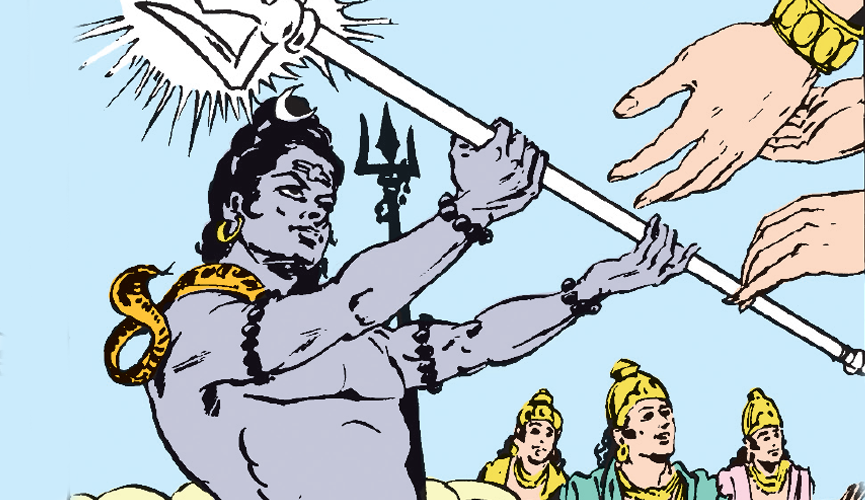
Shiva, the God of Destruction, gifted Durga with his trishul or trident. The three prongs of the weapon symbolize multiple important trinities in the Hindu myth and philosophy. The most common interpretations being the three Gunas (Sattva, Rajas and Tamas), Time periods (past, present and future) and the universal cycles (creation, preservation and destruction) and the wielder of the Trishul is considered to be the master of all such trinities. During the battle, the Goddess used the weapon to land the finishing blow on Mahishasura.
The God of preservation, Vishnu, offered his divine discus, the Sudarshan chakra, to the Goddess. The discus, with more than a million sharp spikes, has the power to decapitate the enemy beyond resurrection. According to Linga Purana, Vishnu obtained the chakra from Shiva and since then has used this weapon to defeat countless asuras and rakshasas in his various avatars. The imagery of the disc spinning around Durga’s finger is a symbolic representation of how the energy provided by the goddess sets the universe in motion.
Brahma, as the God of creation, does not carry any weapons. Instead, he offered his Kamandala, a water pot, to the Goddess. The pot containing holy water symbolises purity, wisdom and life and Brahma uses it to create various life forms by chanting different mantras. Durga’s possession of the Kamandala, which plays a crucial role in the creation of the universe, explains the importance of the existence of Shakti in the universe.
Vajra, the thunderbolt, is Indra’s signature weapon and he offered this mighty weapon to Durga. The weapon was specifically made by Vishwakarma out of Sage Dadichi’s bones so that Indra could defeat Vritra, an asura who is an embodiment of droughts in the Rig Veda. The Vajra is used to punish sinners. In Sanskrit, the word vajra also means a diamond, which is the hardest material found in nature, to symbolise the weapon’s strength and indestructibility.
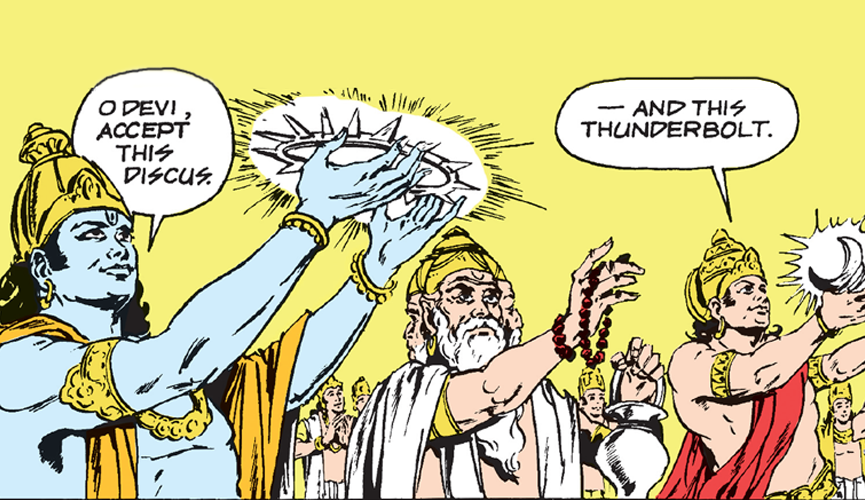
The god of wind, Vayu provided the Goddess with a bow and a quiver with unlimited arrows. The weapon set is a great representation of how Goddess Shakti exists as different forms of energy. The bow and the arrow represent potential and kinetic energy respectively. Before the arrow is launched from the bow, it contains potential energy, but the moment it gets launched towards the target, the potential energy is converted to kinetic energy. And thus, the goddess being an adept archer is a symbolism of how the universe functions due to the conversion of one form of energy to the other.
Varuna, befitting his role as the god of water bodies and marine life, offered his auspicious conch to the Goddess. When blown inside a conch, it produces the sound of ‘Aum’, which in Hinduism is the primordial sound of creation. Water and creation have close ties with each other, as according to modern science, life on Earth started in the oceans. The conch was also used as a trumpet during the start of a war or to declare victory at the end, which is appropriate for Durga as she is the Goddess of war.
Agni, the god of fire and a deity associated with sacred yagnas, offered his spear with a burning head to Durga. The projectile weapon with a sharp-pointed head and enveloped in scorching flames, can impale the target with complete accuracy when launched. The weapon is a symbol of power, valour and courage. The burning flames of the spear signify the role of Shakti as the ultimate source of energy.
Yama, the god of death and justice, gave his sword to the warrior goddess. The sword is an embodiment of both aspects of death and justice. The weapon is utilized by the god to punish the sinners and bring justice to the world. A sword symbolizes bravery, authority and power.
Brahma’s son, Vishwakarma, who was the engineer and carpenter of gods, was responsible for constructing numerous divine weapons. He gifted the goddess an axe, which symbolizes the creative and destructive aspects of energy. An axe used to bring down a tree represents destruction, but using the same axe to chop wood to construct a house represents creation. Thus, symbolizing the dual nature of Shakti in the universe.
The radiant Surya, the celestial Sun God and the ruler of the Navgraha, bestowed his blinding sun rays to the goddess. The blinding radiance of the goddess signifies her duty as the goddess of war to banish evil and darkness in all ten directions. Since every living creature is dependent on sunlight for survival, the light emanating from Durga can also be a representation of her nurturing and nourishing nature as a mother goddess. It also symbolises her role as the universal source of energy.
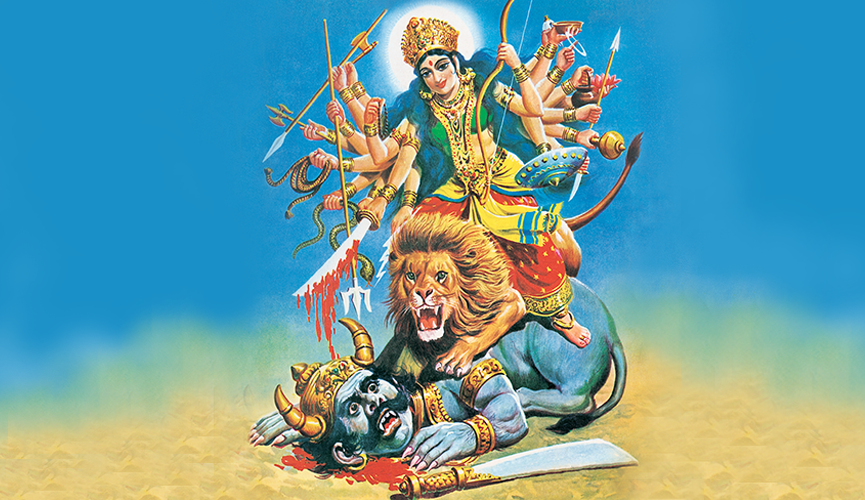
After obtaining offerings in the form of divine weapons and other divine objects from the Trimurti and the devas, the king of mountains, Himavan offered Durga a vahana, the lion. With her ten arms equipped with the power offered by different gods, Durga, who was, as radiant as the sun, rode on her lion and arrived on the battlefield. She challenged the buffalo asura and after a fierce battle that lasted for nine days, Durga defeated Mahishasura, restoring peace in all three realms.
Read the full story of the goddess of war in the title Tales of Durga. It is now available on the ACK Comics app, Kindle, Flipkart, Amazon, and other major e-tailers.
To receive more such stories in your Inbox & WhatsApp, Please share your Email and Mobile number.
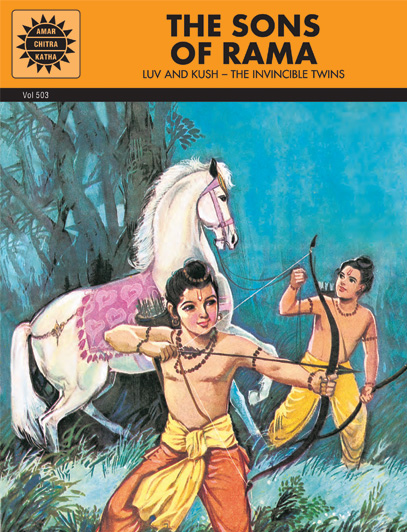
Comic of The Month
The Sons of Rama
The story of Rama and Sita was first set down by the sage Valmiki in his epic poem 'Ramayana.' Rama was the eldest son of Dasharatha, the king of Ayodhya, who had three wives - Kaushalya, Kaikeyi and Sumitra. Rama was the son of Kaushalya, Bharata of Kaikeyi and Laxmana and Shatrughna of Sumitra. The four princes grew up to be brave and valiant. Rama won the hand of Sita, the daughter of King Janaka. Dasharatha wanted to crown Rama as the king but Kaikeyi objected. Using boons granted to her by Dasharatha earlier, she had Rama banished to the forest. Sita and Laxmana decided to follow Rama. While in the forest, a Rakshasi, Shoorpanakha, accosted Laxmana but had her nose cut off by him. In revenge, her brother Ravana, king of Lanka, carried Sita away. Rama and Laxmana set out to look for her and with the help of an army of monkeys, defeated Ravana. On returning Ayodhya after fourteen years of exile, Rama banished Sita because of the suspicions of his subjects. In the ashrama of sage Valmiki, she gave birth to her twin sons, Luv and Kush.